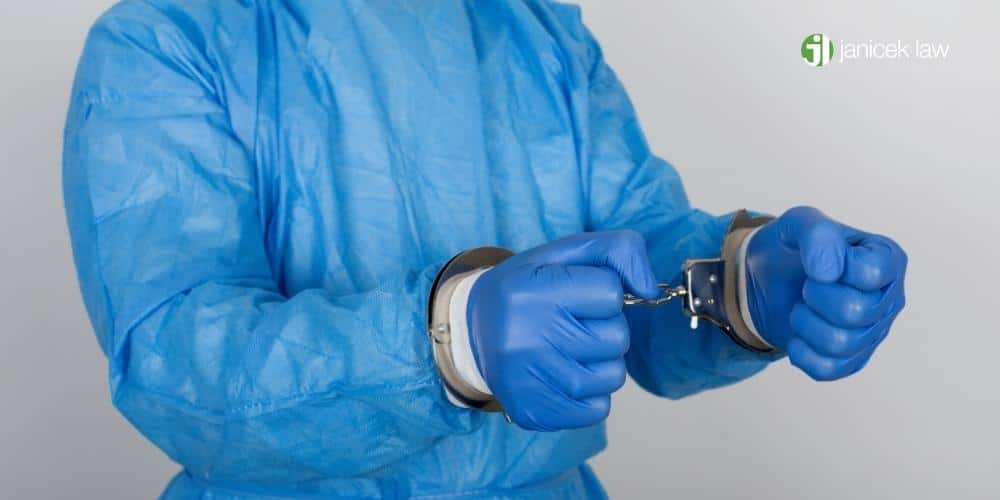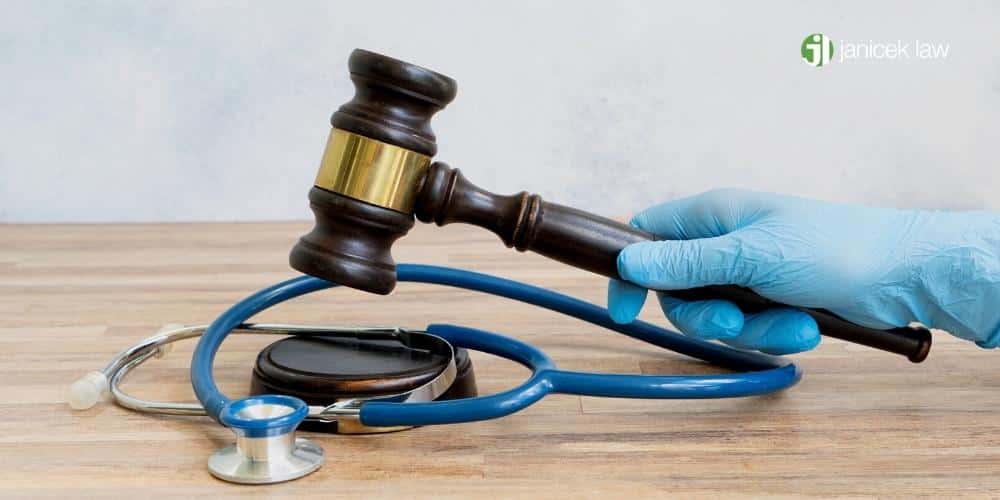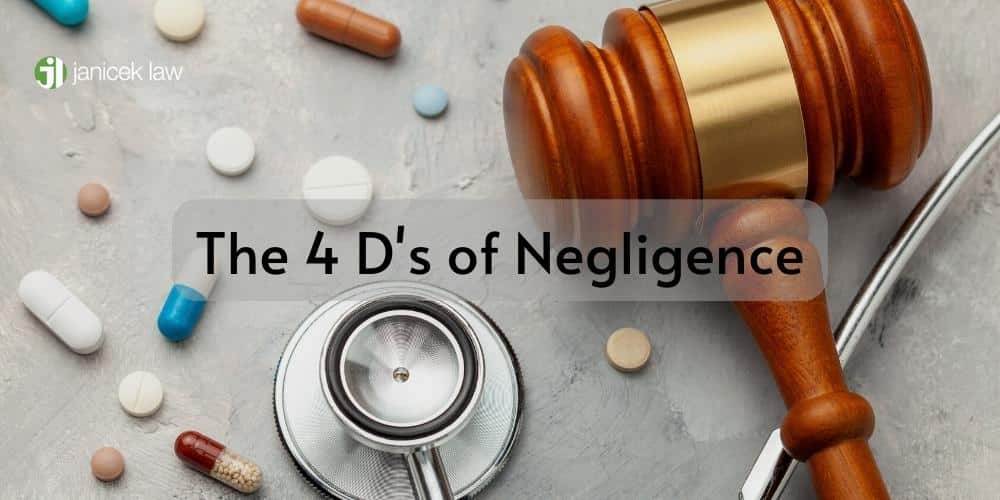For those who are injured in a work-related accident or car accident, or even if you’re just a frequent patient at the emergency room, proper care is what we hope to get. After all, with the price of medical expenses, hospital bills, and surcharge hidden fees, anticipating a certain degree of care as a patient isn’t too much to ask. Unfortunately, not all doctors perform to adequate standards of care for their patients. The San Antonio medical malpractice lawyers at Janicek Law can help you determine whether a healthcare professional’s actions fall within the required 4 D’s of negligence in a medical negligence case. Call 210-366-4949 to schedule a free consultation with us.
Duty of Care
Physicians, doctors, or any other medical experts treating patients in a medical facility have a responsibility to provide the best possible care for their patients. This duty of care to patients should hold up to the same standards of care that other medical professionals in the same field would follow.
Deviation From That Duty
When a healthcare professional deviates from the medical standard of care, that means that they don’t act like a competent doctor would. This breached standard of care may cause physical, emotional, and financial harm to a patient.
When a complex issue, like proving that a healthcare professional’s duty dereliction caused an injury, you need substantial evidence to build a successful medical negligence claim. Establishing a prima facie case of negligence and proving medical negligence can be highly challenging in some cases, even for the best lawyers.
If a healthcare professional deviates from their responsibilities, a jury will need evidence of the following:
- The medical professional did not provide medical treatment that meets an appropriate standard of care.
- Any practicing physician in similar circumstances would have treated the patient differently.
Attorneys at Janicek Law can help you build a strong case by:
- Providing proof that a doctor-patient relationship existed
- Proving that the healthcare professional failed to treat patients with the appropriate standard of care
- Demonstrating the potential health risks that stem from a doctor who fails to provide appropriate medical care
Proving negligence in court isn’t a challenge for every personal injury case.
For instance, suppose a healthcare provider or physician was under the influence of alcohol while performing an operation. He cuts the incision far too wide, causing significant bleeding. With the help of other staff members, the physician controls the bleeding, finishes the surgery, and heads home. On the way home from work, the physician is pulled over and given a breathalyzer test, which he fails. As a direct result of negligence, the patient suffered from infection, insurmountable pain, extended healing time, and a host of other issues that led to a long-term disability.
This example of a personal injury claim is cut and dry. Establishing negligence for this case wouldn’t be difficult, to say the least.
However, establishing negligence for a personal injury claim isn’t usually as simple as the example outlined above, especially for medical malpractice claims.
For example, many believe that if a doctor’s suggested medical treatment is ineffective, they are eligible for compensation. This isn’t the way the law works.
In fact, many healthcare providers actively choose not to take risks, even when it could be more beneficial to their patient, because they want to avoid any potential liability. A standard protocol for medical treatment exists for just about every given scenario you can imagine. So, as long as the doctor provides the same treatment that other healthcare providers practicing within the medical industry would, a patient has no legal recourse for compensation.
Direct Cause
The third element within the 4 D’s of medical negligence claims is direct causation.
Medical errors are the third leading cause of death in the United States. So, when a patient suffers an injury and can prove that medical negligence was the direct cause of their injury, the victim can receive compensation for their damages.
When medical negligence is involved, the original injury will often manifest:
- As a medical condition that worsens after the treatment
- Unexpected, or sometimes, unreasonable complications
- As a need for new medical treatment
Even if a medical professional didn’t cause an injury or medical condition, their actions/inactions could negatively affect the patient’s prognosis, worsen the condition, or cause the patient to require additional treatment.
For example, a delayed cancer diagnosis could ultimately cause a patient with a relatively treatable condition to die. As the patient waits for the correct diagnosis, the cancer progresses and begins to metastasize to other parts of the body. If this has happened to you, contact an experienced San Antonio medical misdiagnosis lawyer at Janicek Law.
However, in order for a patient to have a valid medical negligence case, the doctor’s actions or lack thereof must deviate from the accepted standards of care.
The Burden of Proof in Negligence Cases
The burden for proving causation in medical malpractice claims falls on the patient or plaintiff.
Proving that an injury was caused by a medical professional’s deviation from their duty of care isn’t simple. Every medical procedure comes with acceptable risks. And, even if the physician or nurse does everything by the book, complications from treatments can still occur.
This, in and of itself, would make proving that the healthcare professional’s negligence caused the injury a challenging task at best.
Moreover, medical malpractice cases must be proven by a preponderance of the evidence. A personal injury attorney must convince the jury that the defendant’s actions more than likely caused the victim’s injury. The attorney can bring in medical experts to testify on behalf of the plaintiff, but the decision is ultimately up to the jury.
Now, let’s take a look at the possible defendants: healthcare professionals, nurses, doctors, and hospitals. All of which are typically represented by the hospital’s defense lawyers on retainer. Hospitals will devote a seemingly unending stream of resources to protect their assets, regardless if their staff acted within the scope of accepted practices or not.
Essentially, if you want to have a favorable outcome from your medical malpractice claim, you’ll need a personal injury law firm with the patience, experience, and resources to take on the hospital’s legal team. At Janicek Law, our San Antonio hospital negligence lawyers understand how to sue a hospital in Texas.

Damages
When victims are harmed due to negligence, the type of damages typically will fall into a category of either economic or non-economic damages. When an individual suffers a loss due to medical malpractice, our attorneys will fight for maximum compensation for their damages. The San Antonio medical malpractice attorneys at Janicek Law can discuss the circumstances of your unique case through a free consultation. We know the importance of matters such as the 4 Ds of medical negligence and how much influence that can have on an individual’s life.
What are Economic Damages?
Economic damages, or actual damages, refer to the economic losses that the patient experienced as a result of his or her injury. In medical malpractice claims, the economic damages can often range on the level of severity and factors surrounding the claim.
While each medical malpractice claim is different, economic damages can include:
- Cost of medical treatment, including future medical costs
- Physical therapy
- Prescriptions
- Miscellaneous costs that are associated with ongoing treatment and care, such as gas, hospital parking, wheelchairs, etc.
- Current and future lost wages
A personal injury lawyer will help you and your loved ones gain the opportunity to recover the economic and non-economic damages. Janicek’s experienced attorneys understand the list of challenges your family has faced resulting from medical negligence and how important proving direct causation of medical negligence is for your particular case. If you’ve suffered health consequences from a medical professional (whether this is a nurse or doctor), and the 4 D’s of negligence apply to your situation, call to speak with a medical negligence lawyer at Janicek Law.
What are Non-Economic Damages?
Non-economic damages, or general damages, are the losses that aren’t measurable. They’re the intangible losses that a patient suffers as a direct result of their injury.
While these damages don’t have a direct monetary value, the malpractice victim still deserves to be compensated for them.
Non-economic damages can include:
- Emotional distress
- Pain and suffering
- Loss of consortium
- Disfigurement
- Mental anguish
Trauma can affect a person for the rest of his or her lifetime. Some victims of medical negligence will never be able to fully heal.
The experienced San Antonio medical negligence lawyers at Janicek Law understand the 4 d’s of negligence, how they apply in medical malpractice cases, and the expected standards of hospital and medical care.
What are Punitive Damages?
In Texas, punitive damages are awarded to individuals as punishment for malicious or harmful behavior displayed by the at-fault party. In some cases, courts will try to make common examples out of the individuals’ crimes to prevent repetitive acts in the future. Punitive damages resemble those compared to a “negligent act” and could be awarded in cases that present:
- Wrongful death
- Direct causation personal injury cases
- Catastrophic injury cases
When you or your loved ones find difficulty enjoying life as you once did, our personal injury attorneys want you to know there is hope. Many families that suffered from a hospital or medical provider that acted within the four D’s of medical negligence have benefitted from our attorneys’ help in ways well beyond the legal system. Our San Antonio law firm has an experienced and compassionate medical malpractice attorney ready to support you through your medical malpractice claim.

Experienced San Antonio Medical Malpractice Lawyers
When a loved one suffers from an injury, and the 4 Ds of negligence apply, our medical malpractice attorneys are here to help. Having experienced San Antonio personal injury lawyers fighting for your family through your medical negligence claim means that you will not go through this challenging time alone. A medical malpractice lawyer at Janicek Law understands how much one can lose and that some individuals may never fully recover the damages they suffer.
Our team of attorneys will advocate for your loved ones who have suffered from medical malpractice. When a healthcare provider has an established relationship with a patient, deviates from the standard of care, and this causes the patient pain or injury, this constitutes a valid claim for medical negligence.
Call 210-366-4949 to schedule a free consultation with our San Antonio legal team.

